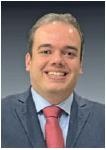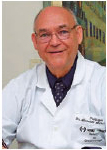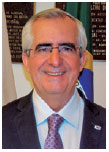Ricardo Noguera Louzada1,2; Adroaldo de Alencar Costa Filho1; Milton Ruiz Alves2
DOI: 10.17545/eOftalmo/2024.0001
Health is considered human beings' greatest asset and is dynamic. The epidemiological profile changes, the age pyramid inverts, and new diseases emerge. Technological progress is rapidly increasing and includes an increase in medical areas and social and communication frameworks, such as internet resources and social networks1.
The basis of eye health should be structured and strengthened in the first years of life, while it is possible to reverse and treat disorders such as amblyopia. Vision develops gradually from birth until around the age of seven, when it reaches the level of adult visual acuity (VA). Around 20%–25% of children of school age have some eye problem, with uncorrected refractive errors, amblyopia, and strabismus being particularly noteworthy2,3. From a public health perspective, routine eye examinations for children are expensive and even unfeasible. Thus, the application of visual acuity testing (VAT) in schoolchildren and the observation of signs and symptoms indicative of eye problems by teachers in class are the most advisable ways of detecting eye problems at school4. In the state of São Paulo, during the School Health Ophthalmology Plan (Plano de Oftalmologia Sanitária Escolar-POSE), from 1973 to 1976, the application of the VAT by teachers in the classroom was in agreement by up to 92.29% with the results of the application of the VAT by ophthalmologists5. However, the percentage of agreement of the VAT applied by teachers of the state school system to schoolchildren in the municipality of São Paulo in the Vision of the Future Program (Programa Visão do Futuro) between 2011 and 2020 decreased to approximately 50%. These data indicate that the teacher requires training to perform visual acuity test correctly. It is emphasized that the teacher plays an essential role in the detection of visual disorders and the implementation and execution of eye health programs for schoolchildren. Living with students on a daily basis allows teachers to detect changes in behavior or school performance that may be linked to visual disturbances6,7. Therefore, it is clear that there is a need for permanent and sustainable national eye health education policies that rescue teachers as key players in identifying schoolchildren who need to be referred to accredited ophthalmology services for a complete eye examination by the doctor.
Moreover, the prevalence of myopia and high myopia is increasing worldwide. World Health Organization's guidelines recommend no more than two h/day of recreational screen time for children aged 5-17 and 1 h/day for preschoolers8. Additional hours of screen time reduces sleep and school performance9. It was noted that outdoor activities inhibited myopia progression in nearsighted children aged 6-7 by 30% in a year10. Bullimore and Brennan (2019)11 showed that one-third of all global visual impairment is attributable to myopia, and every −1.00 D increase in myopia increases the risk of maculopathy by 30%, glaucoma by 20%, and visual impairment by 30%. Moreover, reducing the progression of myopia by just −1.00 D would prevent one million cases of visual impairment in the USA. However, currently, there are no permanent and sustainable national health education policies in the country that can control the progression of myopia in children and/or reduce the risks of visual loss expected in adulthood.
Cataracts are responsible for approximately 48% of cases of visual impairment worldwide and are treatable through surgery. Older adults with low vision because of cataracts lose autonomy in various activities, along with self-esteem, and are highly predisposed to falling12. Cataract surgery is highly efficient and cost-effective in terms of treatment and visual rehabilitation. It is estimated that decreasing corrected VA by 0.5 or less, 5,000 surgeries per million people or 900,000 surgeries/year would be needed13. The expectation of the International Agency for the Prevention of Blindness is 3,000 surgeries per million people to avoid excessive accumulation of unfulfilled demand13. For Brazil to achieve this rate, it would be necessary to update the fees of the Unified Health System (SUS) and make universal accreditation of ophthalmologists in the SUS a reality12.
Glaucoma is the second leading cause of irreversible blindness worldwide. In Brazil, it is estimated that 2%–3% of the population of >40 years of age has the disease (which represents around 1.5 million people), 50%–60% of whom are diagnosed with primary open-angle glaucoma and 20% with primary angle-closure glaucoma13. To reduce the number of people blinded by glaucoma in Brazil, three measures are a priority: increasing public awareness of the disease; ensuring that individuals belonging to risk groups (over 50s, family history of the disease, Afro-descendants, and patients with high intraocular pressure) undergo eye examinations; and guaranteeing access to treatment by providing required eye drops and educating patients about their use14. As the suggestion of the Brazilian Council of Ophthalmology (CBO) and through Ordinance 288 of the Ministry of Health, the Glaucoma Patient Care Program has been prevalent in Brazil since 2008 as a policy to combat blindness due to glaucoma, providing free 1st, 2nd, and 3rd line eye drops for the treatment of glaucoma through the SUS14. However, there is low patient adherence to antiglaucoma eye drops (varying from 30%–80% in the literature15), and not using eye drops properly is related to poor control of intraocular pressure and optic neuropathy, leading to progressive visual loss16. The reasons given in the literature include a lack of knowledge about the disease, forgetfulness, lack of trust in physicians, side effects of eye drops, and patients not understanding the disease well enough to believe that it causes blindness15. This confirms the evident requirement for permanent and sustainable national health education policies for educating patients with glaucoma.
Brazil has the fifth highest incidence of diabetes mellitus (DM), with 16.8 million adult patients (aged 20–79 years), after China, India, the United States, and Pakistan. The estimated incidence of the disease for 2030 is 21.5 million people17. Patients with diabetes are 25 times more likely to develop blindness than those without diabetes18,19. Among patients with type 1 diabetes, 25% may develop some degree of diabetic retinopathy (DR) after 5–10 years, 70% after ten years, and over 90% after 30 years. Among patients with type 2 diabetes, 10% already have some form of DR at the first eye appointment, 25% will develop DR after ten years, and 60% after 15 years20. Hence, it is estimated that DR causes 5% of blindness in the Brazilian population21. The growing number of people diagnosed with DM in Brazil shows the need to implement public health education policies that reduce the statistics of avoidable blindness (which the CBO and its associates have been doing), including raising the level of knowledge of diabetic patients on the topic of DR in DM as a priority in the fight against DM22,23. The main aims of public health education policies are to change attitudes and behaviors, social inclusion, and chronic adherence to treatment. For preventing DR, therapeutic efforts that focus on the risk factors for the onset and worsening of DR and surgical treatment of lesions associated with a high risk of visual loss are necessary24,25. Initially, educating the patient about the disease and strict glycemic control improves any treatment's success. The challenge is always to find a solution to live longer and better. Therefore, it is necessary to develop health policies that ensure an increase in healthy life years, free of illness and disability, an adequate and quality response to people with dependency, and support for families. Promoting, restoring, and maintaining comfort and quality of life should be based on prevention, rehabilitation, re-adaptation, and social reintegration26.
Age-related macular degeneration (AMD) is the leading cause of legal blindness in individuals over 50 years. In industrialized countries, the prevalence of blindness is 8.7% among individuals affected by the disease12. Around 23 million Brazilians are over the age of 65 years, and approximately 14% of them (approximately 3 million people) have AMD. Among these, 10%–15% have neovascular AMD (which accounts for 90% of cases of blindness). The current standard treatment for the neovascular form of AMD is intravitreal injection of vascular endothelial growth factor inhibitors. Patients with low vision need visual rehabilitation, psychological support, and environmental adjustments. The main risk factor for AMD is advanced age. Moreover, Caucasian ethnicity, atherosclerosis, smoking, and specific genetic polymorphisms are associated risk factors. However, of all these factors, only smoking is a controllable factor, and ending it may reduce the risk of the disease and its progression.
Although artificial intelligence systems can detect glaucoma, DR, and AMD without the need for a physician to interpret the image or results27,28, current health policies developed by governmental and non-governmental organizations are insufficient to provide control or at least minimize the harmful effects of these diseases on people's vision in the coming years. Therefore, the incorporation of technologies, together with health education policies, is desirable to guarantee quality, low-cost, and highly efficient healthcare.
REFERENCES
1. van der Loo T, Britto A. In: SPDM (org). Prefácio. A Saúde no Brasil em 2021. Reflexões sobre os desafios da próxima década. São Paulo: Cultura Acadêmica, 2012:p.9.
2. Alves MR, Kara-José N. Triagem visual na escola. In: Alves MR, Kara José N (Eds.). O Olho e a Visão. O que fazer pela saúde ocular de nossas crianças. São Paulo, Vozes, 1996, p.79-84.
3. Kara-José N, Alves MR. Problemas oculares mais frequentes em escolares. In: Conceição JAN (Coord.). Saúde Escolar. A criança, a vida e a escola. São Paulo, Sarvier, 1994, p. 195-2003.
4. Temporini ER. Aspectos do Plano de Oftalmologia Sanitária do Estado de São Paulo. Rev Saude Publica. 1982;16(4):243-60.
5. Temporini ER, Kara-José N, Taiar A, Ferrarini ML. Validade da aferição da acuidade visual realizada pelo professor em escolares de 1a à 4a série de primeiro grau de uma escola pública do município de São Paulo, Brasil. Rev Saude Pública. 1977;11(2):229-37.
6. Armond JE, Temporini ER, Alves MR. Promoção da saúde ocular na escola: percepções de professores sobre erros de refração. Arq Bras Oftalmol. 2001;64(5):395-400.
7. Alves MR, Temporini ER, Kara-José N. Atendimento oftalmológico de escolares do sistema público de ensino no município de São Paulo. Aspectos médicos-sociais. Arq Bras Oftalmol. 2000;63(5):359-363.
8. Chaput JP, Willumsen J, Bull F, Chou R, Ekerlund U, Firth J, et al. 2020 WHO guidelines on physical activity and sedentary behaviour for children and adolescents aged 5–17years: summary of the evidence. Int J Behav Nutr Phys Act. 2020;17(1),141.
9. Gentile DA, Reimer RA, Nathanson AI, Walsh DA, Eisenmann JC. Protective effects of parental monitoring of children's media use: a prospective study. JAMA Pediatr. 2014;168(5):479-84
10. Wu PC, Chen CT, Lin KK, Sun CC, Kuo CN, Huang HM, et al. Myopia Prevention and Outdoor Light Intensity in a School-Based Cluster Randomized Trial. Ophthalmology. 2018;125(8):1239-1250.
11. Bullimore M, Brennan N. Myopia Control: Why Each Diopter Matters. Optom Vis Sci. 2019;96(6):463-465.
12. Alves MR. Programas de combate às causas prevalentes de baixa Visão Visão e Cegueira. In Alves MR. Política Nacional de Atenção a Oftalmologia. In Abib FC, Alves MR, Kara-José N. Tema Oficial do 62º Congresso Brasileiro de Oftalmologia Maceió 2018. p.297-305.
13. Alves MR, Castro RS. Situación atual de la cirugia de catarata em Brasil. Resultados do Ministerio de la Salud Y del Consejo Brasileño de Oftalmologia. In: Arieta CEL, Duerksen R, Lassingh V. Manual de Ceguera por Catarata em America Latina. Vision 2020. Bogotá, 2011.193-7.
14. Umbelino CC. As condições de Saúde Ocular no Brasil 2023. Disponível em: em: https://static.poder360.com.br/2023/06/condicoes-saude-ocular-cbo-2023-oftalmologia.pdf, Acessado em 09/05/2024.
15. Newman-Casey PA, Robin AL, Blachley T, Farris K, Heisler M, Resnicow K, et al. The most common barriers to glaucoma medication adherence: a cross-sectional survey. Ophthalmology. 2015:122(7):1308-16.
16. Lee PP, Walt JW, Rosenblatt LC, Siegartel LR, Stern LS; Glaucoma Care Study Group. Association between intraocular pressure variation and glaucoma progression: data from a United States chart review. Am J Ophthalmol. 2007;144(6):901-907.
17. IDF Diabetes Atlas 2021. International Diabetes Federation. Disponível em: https://diabetesatlas.org/atlas/tenth-edition/ Acessado em 05/05/2024.
18. Souza I. Avaliação da resolubilidade no encaminhamento de pacientes diabéticos ao oftalmologista em um centro de atendimento especializado do oeste do estado do Paraná. TCC (Graduação em Medicina) - Universidade Federal do Paraná. Toledo, p. 42. 2022.
19. Ghamdi AHA. Clinical Predictors of Diabetic Retinopathy Progression; A Systematic Review. Curr Diabetes Rev. 2020; 16(3):242-247.
20. Lechner J, O'Leary OE, Stitt AW. The pathology associated with diabetic retinopathy. Vision Res. 2017Oct:139:7-14.
21. Hirakawa TH, Costa WC, Nakahima F, Ferreira AIC, Ribeiro LB, Ticianeli JG, et al. Conhecimento dos pacientes diabéticos usuários do Sistema Único de Saúde acerca da retinopatia diabética. Rev Bras Oftalmol. 2019;78(2):107-111.
22. CBO 24 horas pelo Diabetes. Disponível em: https://www.conass.org.br/24h-pelo-diabetes-cbo-mobiliza-mais-uma-edicao-para-conscientizar-sobre-doenca-que-pode-causar-a-cegueira/. Acessado 29/04/2024.
23. Campanha Diabetes Novembro Azul no CIDH alerta para diagnóstico e prevenção de riscos da doença. Disponível em https://www.saude.ce.gov.br/2023/11/13/novembro-diabetes-azul-diagnostico-prevencao-riscos/ Acessado em: 29/04/2024.
24. Diretriz da Sociedade Brasileira de Diabetes – Update 2/2023. Disponível em: https://diretriz.diabetes.org.br/metas-no-tratamento-do-diabetes/ Acessado em 29/04/2024.
25. Lavinsky J, Borges RM, Lavinsky D. Retinopatia diabética. In Moreira Jr CA, Lavinsky J, Ávila M (eds): Retina e Vítreo. Série Brasileira de Oftalmologia 2023, p.185-214.
26. Oliveira Jr. JRN. Cidadão e família no centro do sistema. In: SPDM (org.) A Saúde no Brasil em 2021. Reflexões sobre os desafios da próxima década, São Paulo: Cultura Acadêmica.2012.p86-88.
27. Louzada RN, Belizário IV, Traina AJ, Alves MR. Importância do algoritmo como ferramenta para tomada de decisão do especialista: inteligência artificial na oftalmologia. eOftalmo. 2022;8(3):61-4.
28. Louzada RN, Belizario IV, Monteiro MLR, Porto FBO, Alves MR, Traina AJM. Inteligência artificial nos exames de imagem: Como manter os dados para o futuro. eOftalmo. 2023;9(3):99-101.
AUTHORS INFORMATIONS |
|
 |
» Ricardo Noguera Louzada https://orcid.org/0000-0002-9610-5768 http://lattes.cnpq.br/5978866539118374 |
 |
» Adroaldo de Alencar Costa Filho https://orcid.org/0009000792979111 http://lattes.cnpq.br/3152075298233631 |
 |
» Milton Ruiz Alves https://orcid.org/0000-0001-6759-5289 http://lattes.cnpq.br/6210321951145266 |
Funding: No specific financial support was available for this study.
Conflict of interest: None of the authors have any potential conflict of interest to disclose.
Received on:
May 11, 2024.
Accepted on:
May 23, 2024.